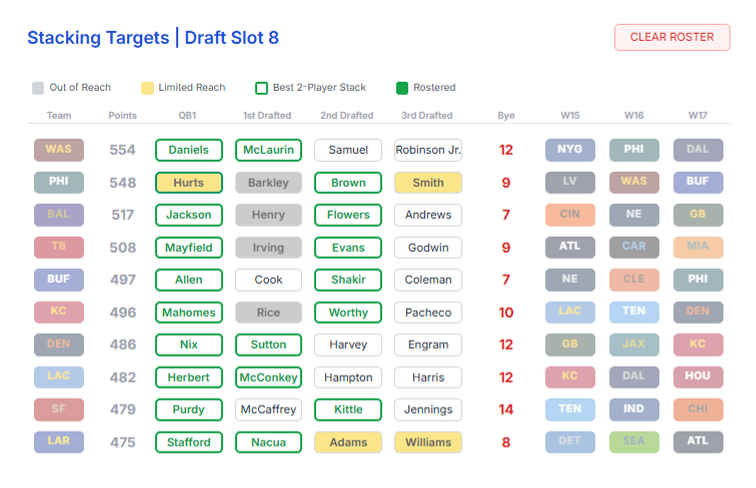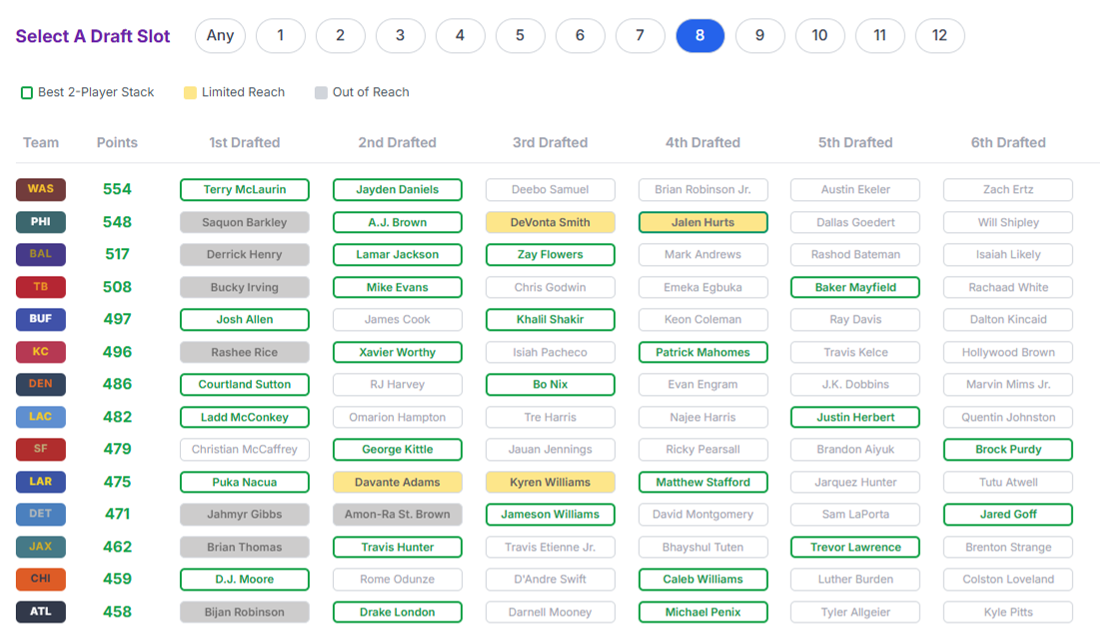Learn More
This page is a deep dive into the data and model behind the Team Builder and Cheat Sheet. It explores how player reachability is determined and team-stacks are ranked.
If you're looking for a tutorial on how the Team Builder works, you can find that here.
If you're looking for further reading on Best Ball, you can find that here.
Thanks for visiting and good luck in your drafts!
Overview
This site, and especially the Team Builder, is designed to be a sandbox for discovery and experimentation with Best Ball team-building. As ADPs shift throughout draft season, new stacking opportunities and unique roster correlations constantly evolve and emerge. Built on live ADP data from ongoing Underdog Fantasy drafts, this site aims for a flexible view of the current drafting landscape for trend-exploration, pre-draft planning, and live-draft decision-making.
What follows is a review of how the data is presented in that sandbox.
Default Team Stacking Targets
When you first select your draft position, the Team Builder
gives you a default list of Stacking Targets.

This is simply a snapshot of what’s realistically buildable in the average draft room today. It aims to answer the question:
“Based on current ADPs, what are the best stacks I can reasonably target from this draft position?”
To do so, the model first determines the expected draft range of every player based on their current ADP. Second, it checks to see which draft slots own a pick within that player's expected draft range. In doing so, the model assigns every player a reachability status —in-reach, out-of-reach, or limited-reach — for every draft room position (1-12).
Limited-reach applies when two or more players on the same team are tightly grouped in ADP—and your slot doesn’t have enough picks in that range to get them both (or all).
There is also a secondary player designation for Best 2-Player Stack. This designation is reserved for the team's most valuable 2-player combination (excl. RBs ) within reach of your selected draft slot. The logic behind this is discussed in more detail below.
Determining Expected Draft Range
The model determines a player's expected draft range by applying reach and fall margins to their ADP. Reach is how early a player might go. Fall is how long they might last.
These ranges are round-dependent. Early round reach/fall ranges assume tighter adherence to ADP whereas later rounds account for more chaotic behavior. The following table provides and example of how these ranges expand throughout the draft.
| Round | Max Reach (Before ADP) | Max Fall (After ADP) |
|---|---|---|
| 1 | +2 | -1 |
| 6 | +7 | -6 |
| 12 | +13 | -12 |
In Round 1, this means drafters typically won't reach more than 2 spots down the ADP board, and players rarely fall more than 1 spot. For example, the ninth overall player by ADP (e.g. Malik Nabers at the time of writing) would have an expected draft range of picks 7-10. By Round 6 the range becomes much looser—a player with an ADP of 66 (e.g. James Conner) would have an expected draft range spanning picks 60 to 72.
In general, these ranges are intended to reflect a 50% probability of player availability, based on historical ADP variance. If you would like to learn more about historical variance and behavior in Underdog Fantasy drafts, Hayden Winks’ article Everything I Think About When Drafting NFL Best Ball Teams is an excellent resource to check out.
ADP Clusters
The model groups players from the same team into ADP clusters when their expected draft ranges overlap. If the expected draft range of a cluster contains more players than your slot has picks, the players within the cluster receive the limited-reach designation. Limited-reach means in the average draft room, you likely can draft one (or some) of the players in the cluster, but not all.
2-Player Stack Model
As mentioned earlier, the Team Builder and Cheat Sheet provide a ranking of the best available stacks for your selected draft slot. This ranking is based on the projected point total of the team's best 2-Player (non-RB) stack available. Projected points are also directly from Underdog – they are the same projections you see in your draft room.
Why 2-Player? Why exclude RBs?
A 2-Player stack is the least common denominator of stacking – typically a QB and their best pass-catching teammate. Historically, the QB+1 stack delivers the highest likelihood of spike week correlation between teammates. Alternatively, RBs and QBs are often negatively correlated when it comes to spike week performance.
This is not to suggest there aren't RB archetypes that correlate higher with their QB, nor is it intended as a guidance on the ideal size of a stack – that is entirely up to the drafter. For more on team-building strategies in Best Ball, check out this list for further reading.
As an example, the below table from the Cheat Sheet displays a ranking of team stacking targets for Draft Slot 8 and the reachability designation of each regularly drafted player on the team.

- Jayden Daniels + Terry McClaurin (554 pts) is the highest projected 2-Player stack available. All of Washington’s core weapons are also likely within reach to build a larger stack.
- Jalen Hurts + AJ Brown (548 pts) is second—but Hurts and Devonta Smith are tightly ADP-clustered, so building a larger stack with all three is unlikely.
- Patrick Mahomes + Xavier Worthy (496 pts) ranks sixth for draft slot 8. The best possible 2-Player KC stack is Mahomes + Rashee Rice, but Rice is likely unavailable here.
Team Tiers
The Team Builder organizes teams into 4 tiers—Elite, Good, Mid, or Poor. Tiers are based on the projected fantasy points of the team's best possible 2-Player stack. They are meant to organize teams by QB+1 stacks of similar value and are agnostic of draft slot.
| Tier | QB+1 Projected Points |
|---|---|
| Elite | ≥ 515 points |
| Good | ≥ 480 points |
| Mid | ≥ 445 points |
| Poor | < 445 points |
For example, the QB+1 stack for the Texans (CJ Stroud + Nico Collins), the Jaguars (Trevor Lawrence + Brian Thomas), and the Chargers (Justin Herbert + Ladd McConkey) are all projected (as of 6/24/2025) to score between 480-515 fantasy points. Teams change tiers when they break the necessary threshold up or down.
Summary
This site, and in particular the Team Builder, is intended for use as a Best Ball team-building sandbox.
To aid discovery and exploration, it models stack reachability using real-time ADP data, round-based variance, and slot-specific constraints. Stacking opportunities are ranked on the projected value of the best available 2-Player stack. To give a sense of the best possible stacks compare, it organizes teams into tiers by projected fantasy points.
Use this as a launchpad — everything is built to be explored, filtered, and tailored.
ADP and point projections are based on data from Underdog Fantasy. This site is not affiliated with or endorsed by Underdog.
All modeling, analysis, and data transformations presented on this are proprietary to Best Ball Team Builder.